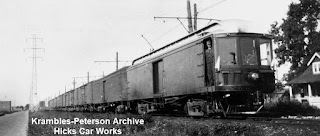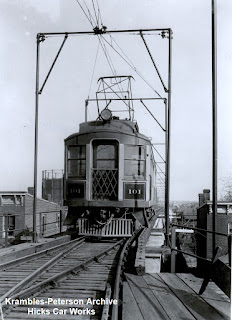Regarding the Red Cars
by Art Peterson
All photos from the Krambles-Peterson Archive
Nope, it’s not about the Pacific Electric, but about that “other” red car outfit – Northern Ohio Traction & Light (NOT&L). This time of year, I always think of that great McKinley Crowley shot of the NOT&L cars working their way up the snow-covered Tuscarawas Street in Canton (see below). Of course, there’s a lot more to the NOT&L story than just that one photo, and as you dig into the pages of the Electric Railway Journal or other periodicals, you find fascinating tidbits. To vary things from the normal chronological order, the photos following are presented in car number sequence.
NOT&L 51 – Tuscarawas Street, Canton – McKinley Crowley Photo
This photo absolutely conveys that warm, inviting feeling of the big car having drawn up to rescue you from the bitter cold day. NOT&L 51, a 1902 St. Louis product, originally built for the Canton-Akron Railway, has crossed the B&O tracks near the Canton carbarn, headed for Massillon. Today, a Ford dealer occupies most of the former carbarn site (behind the photographer). The Canton-Akron was merged into the NOT&L on October 1, 1906. Eventually the 51 would be renumbered to NOT&L 1451. The three cars in this group were among the 1928 car scrappings, as interurban traffic fell off and lines began to be abandoned.
NOT&L 82 – Northfield Cutoff – Company Photo
For the 1916 car order, NOT&L turned to Jewett to deliver the 15 members of this group (cars 80-94). These cars were a little over 5% lighter than the road’s previous steel cars, which had come from Kuhlman in 1914. The Jewetts used a steel girder-type underframe (comprising commercial sections and pressings), which was expected to give a longer service life at lower cost. In addition, the 80-series cars were delivered with four GE 240B motors, each producing 105hp, where the previous cars had come with four 75hp GE motors. This order would come late in the life of the Jewett plant – the firm was in receivership by October 1918. Over three-quarters of NOT&L’s 1916 revenue had come from the railway (interurban and city car) operations; the balance was from the power business.
This photo was posed on the Northfield cut-off, which opened in 1913. The 7.5-mile section of line extended from Chittenden (north of Cuyahoga Falls) to Fells (north of Northfield). The double-track road took 2 years to construct. No curve exceeded 1 degree and no grade was stiffer than 0.5%. Catenary towers on a 300-foot spacing were supplied by Archibald-Brady of Syracuse, NY. Why Syracuse? Archibald-Brady had supplied nearly identical towers to the Rochester Syracuse & Eastern, whose line section to the west of Syracuse was the model for the NOT&L’s improved line.
NOT&L 1024 – Market at 6th Street, SW – Canton – 1927 – McKinley Crowley Photo
The rate of sidewalk superintendence to actual workers is extremely high in McKinley’s excellent period view. Love the letter-drop in the foreground, too!
NOT&L’s Market line served the Pennsy’s Canton station at 9th Street and stopped just shy of the W&LE line near 17th Street. Spun off from NOT&L control in June 1930, the Canton local lines continued operation as the Canton Traction Company until April 18, 1931, when all car operation ended.
The 1024 had been built in NOT&L’s shops in 1900 and was equipped with Peckham trucks, GE 68 motors, and K6 control. NOT&L scrapped this car on December 12, 1929.
NOT&L 1075 – South of Bedford – McKinley Crowley Photo
NOT&L’s shop crews did a superb job of converting passenger car 1462 (Kuhlman, 1908) into handsome box motor 1075. The 1462 had been a good choice for this service, since it was built with steel plate reinforcement on the carsides. Gearing was changed to 17/60 to provide greater starting torque, such as this nine-car train would require.
NOT&L predecessor, the Akron, Bedford & Cleveland had been a member of the Electric Package Company (agency) in concert with other area interurban roads. In April 1922, NOT&L reached agreement with other area roads on a joint freight service agreement; Detroit United was later a party to this agreement. In the interest of promoting the interline connections, NOT&L equipped its box motors with MCB couplers, as the 1075 has in this view. Within 6 months of having started the joint operations, NOT&L had doubled the freight car-miles operated. Fourteen additional trailers were on order and the shops were in process of converting another two cars to freight motors.
NOT&L 1148 – Kuhlman Plant, Cleveland - 1926
The photographer’s choice of cars to document for this order was fortuitous – the 1148 was burned the next year (on August 2, 1927) at Detrick Siding. The car was scrapped on March 1, 1928. This view also shows NOT&L’s practice of painting the body their traditional red while the cars ends were painted orange.
NOT&L went “from zero to 60 in 3 seconds” on the freight service. As written in the previous caption, the interline freight agreement dated to April 1922. By 1925, NOT&L was carrying nearly 107,000 tons of freight and posted revenues of $615,000 on this traffic, its peak year. A fleet of 59 freight trailers and 24 motors were engaged in this work. The road was advertising overnight freight deliveries to Detroit and to Pittsburgh and ERJ reported on NOT&L getting 670 pounds of forgings from Alliance to Detroit in just five hours.
But, at the same time, something else was experiencing an increase in Ohio. The number of trucks registered in the state increased by 140% between 1920 and 1926. In the next five years truck registrations would rise by a further 16%.
NOT&L 1434 – October 1920 – Company Photo
Major League baseball desperately needed to demonstrate that the scandal-plagued 1919 World Series was an isolated incident. There was a lot riding on the 1920 series, which pitted the Brooklyn Robins (the team name used from 1914 to 1931) against the Cleveland Indians (Cleveland’s first trip to the World Series). The first three games were played in Brooklyn and from Saturday, October 9th, the focus shifted to Dunn Field in Cleveland.
With attendance at the Cleveland games all exceeding 25-26,000, NOT&L and other carriers were ready to carry the fans to/from the game. This nine-car train was one of the specials assembled for this purpose. Franchise restrictions in Cleveland meant that the nine-car consist would have to be split into a trio of three-car trains within the city limits.
Head car 1434 (Kuhlman, 1910) wears the distinctive Washington sash side window design, as does the second car, 1478 (Kuhlman, 1914). The third car has conventional window sash design with a letterboard above the windows.
NOT&L 1511 – AREA Cleveland Convention, October 1926 – Company Photo
Those handsome 1500s! Kuhlman’s stunning design used on the 1920 and 1921 orders for NOT&L was further enhanced by the addition of 56” wide parlor windows (with Edwards brass sash); car 1511 also received Timken roller bearings as part of this September 1926 rebuilding, done at Kenmore Shops in Akron. Limited service had first been run by NOT&L from March 1911. The success of this service contributed to NOT&L’s 11.2% increase in gross earnings for 1912, compared to the 1911 results.
However, the year 1926 was marred by labor unrest on the NOT&L. Amalgamated Association members shut down interurban and most city car service on May 2, 1926. Accounts in the
Electric Railway Journal ominously noted that 58 buses were running in place of the interurban cars, departing Akron every 9 minutes throughout the day. These accounts also observed that the bus fare was 40% higher than what was charged on the cars. The strike was finally settled on May 22nd. The operating results for 1926 showed the disturbing results – gross earnings for the transportation division were off 7.4% for 1926 compared to the previous year, while the power business increased nearly 19% over that same period.
NOI 1523 – Broadway-Miles, Cleveland – October 1931
The July 5, 1930, formation of Ohio Edison required that the rail operations be divorced from the utility business. With this separation, the interurban operations were carried on by the Northern Ohio Interurban (NOI) Company, while the Akron Transportation Company ran the city car service. Both companies were under the control of the Transportation Securities Company of New York.
Car 1523 (a member of the 1921 order for Kuhlman-built interurbans) is shown during the brief period in which NOI had this responsibility – the Ohio Public Utilities Commission would grant permission for abandonment of the interurban route on February 29, 1932. The last interurban train from Cleveland was a three-car train of 1500s leaving at 1 am on April 1, 1932.
The view also shows the item which most-handicapped the interurban – the long sections of street running in Cleveland or elsewhere. Harry Christiansen, in his 1965 book, noted that the average speed of the cars on private ROW could approach 47 mph – a very respectable average. However, when the entire 1 hour, 15-minute run time for a limited on the 33.78-mile Cleveland-Akron line is considered, the average speed falls to 27.02 mph.
NOT&L tried aggressively to improve its competitive position. For example, as late as 1925, the NOT&L had reached agreement with the Wheeling & Lake Erie to relocate 4.5 miles of its line between Bedford and Whitehouse adjacent to the steam road track, eliminating another section of in-road ROW.
Acknowledgements: As noted in the captions, much of the material cited above came from the pages of the Electric Railway Journal and Electric Traction. In addition, CERA Bulletin 109 (1966) and Harry Christiansen’s 1965 book on interurbans of Northern Ohio were also consulted. Numerous on-line sources were reviewed to include local context. As always, the willingness of Randy and Frank to publish this on the blog is most-sincerely appreciated!
This article was edited by Frank Hicks







































.jpg)








.jpg)









